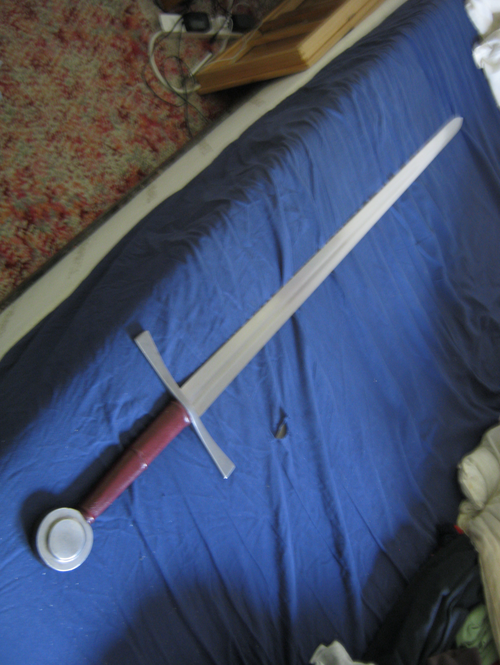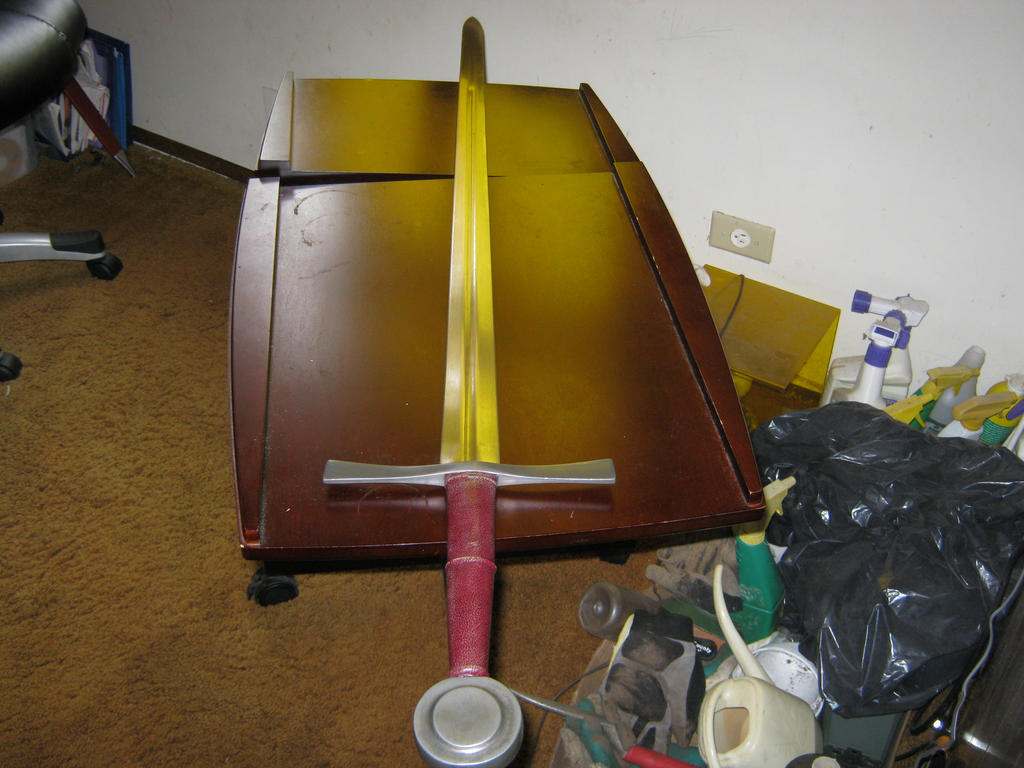Review: Pre-Owned Del Tin 14th Century Hand and a Half Sword
Jun 9, 2013 19:24:26 GMT
Post by Dryhavich on Jun 9, 2013 19:24:26 GMT
This is my first review of any sword. 

Introduction
Ever since I first discovered the modern sword community on Youtube, I was fascinated by the wealth of information that existed about European swordsmanship. I threw away my various misconceptions I had about swords, and delved deep into medieval history. After watching people cut with majestic blades, especially longswords, I knew I had to get one. I started out by purchasing a wooden waster with mediocre handling, but was built quite tough. Studying the tradition of Johannes Lichtenauer by myself with a wooden sword did not satisfy me completely, and I realized that a proper sword was needed for such a pursuit.
Now, almost four years later, I posted a topic on this forum about possible Type XIIa/XIIIa swords to buy, and one such model piqued my interest - the DT5143. This was a pre-owned sword, cut to nearly half its price on Kult of Athena due to some minor pitting on the pommel and guard and moderately deep scratches running for about 5 inches on the blade. www.kultofathena.com/product.asp ... Half+Sword
I promptly bought it while it was still available, and also purchased a scabbard for it by Crusader Monk. (more on the scabbard later) When the whole package arrived in an enormous box not even 2 weeks after I ordered it, I was dumbstruck, and slowly opened it. Inside was a ton of packaging paper, which I carefully dug through to reveal a scabbard - I was excited already... The moment I saw the whole thing, I felt like a little kid who had received his first Christmas present. (do note that the box was destroyed in test cutting experiments shortly afterwards )
)

Historical Overview
The family of Type XIII swords was designed largely as strong-striking swords of war, fit for the combat that occurred during the 13th and early 14th centuries (there are actually a few examples of this type dating to the 12th century, some even possessing quasi-viking-era hilts). Such swords were meant to track exceedingly well in the cut and deliver mighty, fight-stopping blows against the riveted maille and padding of the time, which was extremely resistant to shearing blows. Blows against unarmored targets or those wearing light textile would be horrendous. Their tips were often spatulate, though still serviceable against unarmored targets, and providing excellent cutting capabilities at the tip. The DT5143 replicates the subtype XIIIa, which were hand-and-a-half longswords.
Some examples from myarmoury.com that may have inspired the DT5143:


Full Disclosure
I am in no way affiliated with Kult of Athena, Del Tin, or Crusader Monk. I purchased this sword pre-owned from Kult of Athena, and the scabbard/suspension also through Kult of Athena and made by Crusader Monk. The sword's price was about $259 before tax and shipping, (again, its pre-owned condition cut the price a bit) and the scabbard/suspension was $275 before tax and shipping.
This sword was recommended to me by forum member Curtis_Louis, and I'm quite grateful for that recommendation now.
I have practiced and studied German longsword on my own with a wooden waster for a few years without formal training, though I have never done any test cutting on any medium except with some random knives.
Initial Impressions
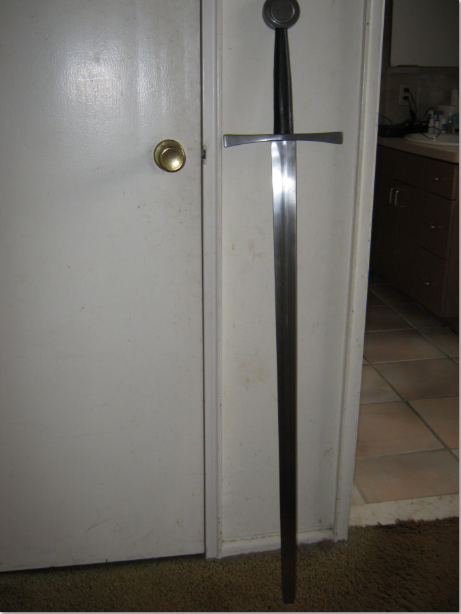
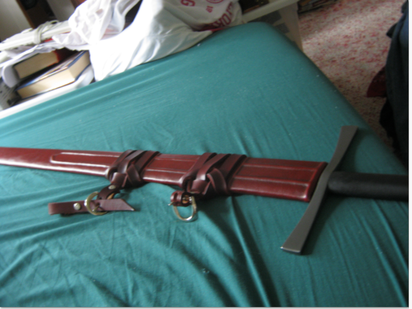
Oh yeah, remember that wooden longsword waster? Here it is beside the DT5143:

Wow! The moment I took the sword and scabbard out of the box, I was surprised at how light everything felt in my hands. The guard's pitting was exaggerated in the description, being barely visible at all. The pommel had a bit more pitting than one would have thought from the pictures, but actually makes the sword very handsome by its antiqued finish. When I took the blade out of its scabbard, which was also extremely attractive, (and nice-smelling) its finish surprised me - I also found the scratches on the blade described by KoA, but they were very isolated and hard to see unless one looked close in certain light. Doing a few test swings REALLY surprised me - I knew that the blade weighed almost four pounds from the specs given by KoA, but it did not feel nearly as heavy. (more on this in the handling section) The blade came somewhat sharpened, with a noticeable secondary bevel,and is sharpened unevenly - one edge is nearly paper-cutting sharp near the bottom of the blade, while becoming duller near the upper COP and the tip. The other edge is about the same sharpness as that latter part. The guard was slightly rattly and slightly loose, causing the sword to make a bit of an ugly noise when struck, and a wee bit of the upper part of the leather wrap came loose. I fixed the upper part of the wrap with some acrylic glue, and now is completely fine.
(Note: I'm not sure if the original seller sharpened the sword themselves or if KoA sharpened it.)

Statistics
Blade Length: 38.5625"
Handle Length: 7.4375"
Pommel Length: ~2.4375"
Overall Length: ~48.5"
Guard Width: ~8.8125"
POB: ~5.5"
COP: Very large, starts at about 14.5" down the blade, and ends at about 28" down the blade.
Weight: ~3.84 lb (3 lb, 13.4 oz)
Components
The Blade

This is a Type XIIIa blade, possessing the characteristic features of the type. It is quite heavy and wide, though not as wide as some examples, has a long fuller running for a bit more than 2/3 of the blade's length, has a spatulate point, features little profile taper with nearly-parallel edges, possesses sufficient distal taper, and is of lenticular cross section. It's definitely more flexible than my Hanwei-Tinker Viking, but it is nowhere near whippy. I adore Type XIIa/XIIIa blades because of these features, and this blade is no exception to that...
The Handle

The handle is pretty simple, being black leather over a wood core. It is nicely shaped and tapered, and quite comfortable to hold. My hands are of average size, and the grip provides plenty of room for them.
The Guard
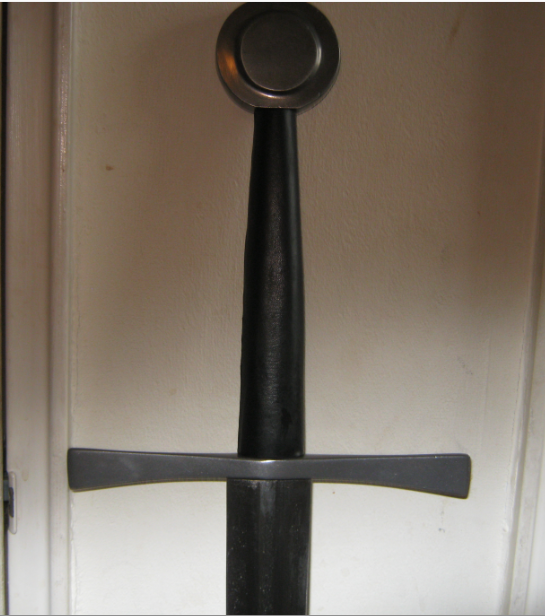
The guard is a nicely-done style 5 cross, with a slightly antiqued finish and very minor pitting. As I mentioned before, it rattles a tiny bit, but is not really an issue in my mind, as it does not seem to affect how the sword handles, looks, or cuts.
The Pommel

The pommel is a very large and heavy Type H. It tapers in thickness, which makes it a relatively comfortable gripping surface for certain meisterhau. It's got a fair bit of pitting, but this combined with its antiqued finish makes it look really cool. If used in a mordhau, where the swordsman flips the blade around and grasps the blade in their hands, striking the opponent with the pommel, this specific pommel would be truly devastating to even a target armed in plate armor.
The Scabbard

The scabbard was made by Crusader Monk, (Odingaad or "Sarge" on here) and it is red-dyed leather with an oxblood-dyed leather belt and suspension. The leather is of very nice quality, and is mostly devoid of imperfections, at least to my eyes. The very end of the scabbard (the sword-point end) seems to be not as joined together as the rest of the piece, but it does not seem to be falling apart at all or taking away from visual appeal. The hemp risers are very nicely done, and give the scabbard some serious flair. The sword's fit inside the scabbard is not the best, with the blade able to fall out with its own weight if held directly upside down. I have not attached the leather suspension hangers to the scabbard just yet, for one of them needs a hole or two punched in it so I can mount it on the scabbard.
Handling Characteristics
Alright, back to my absolute favorite part of this sword! :mrgreen:
Remember when I mentioned that this sword weighs nearly 4 pounds? I wasn't kidding.. I weighed it on a scale that registered it as 3.84 pounds. I am a 5'9", 148-pound student about to go off to college with a compact but very sturdy body, and not overly strong. This blade NEVER feels like what it really weighs in the hand... in a two-handed grip, it really comes alive. Short chops can be done with ease, all of the meisterhau (zornhau, unterhau, krumphau, etc.) can be executed properly, edge alignment is really easy, heck... it even tracks alright in the thrust. Long, sweeping cuts are definitely this sword's strong point, (or should I say "edge", 'cause it's a type XIIIa? ) but it can do most other things as well. The blade presence that this thing has is immense, though does not make it feel any heavier. People may think of High Medieval swords of war as heavy, ponderous weapons, but that is far from the case. Even though many of them weigh as much as or more than four pounds, that is quite deceptive. These swords were designed to be easily used on the battlefield with proper technique, and the strikes that they could deliver were extraordinary. I suspect that the DT5143's fine balance, good distal taper, and astounding mass distribution all culminate into making it an easy-handling sword. I also tried out some one-handed strikes with this sword, and it performed quite well even with the weight, though it seemed a bit unnatural to make single-handed cuts with such a large blade.
) but it can do most other things as well. The blade presence that this thing has is immense, though does not make it feel any heavier. People may think of High Medieval swords of war as heavy, ponderous weapons, but that is far from the case. Even though many of them weigh as much as or more than four pounds, that is quite deceptive. These swords were designed to be easily used on the battlefield with proper technique, and the strikes that they could deliver were extraordinary. I suspect that the DT5143's fine balance, good distal taper, and astounding mass distribution all culminate into making it an easy-handling sword. I also tried out some one-handed strikes with this sword, and it performed quite well even with the weight, though it seemed a bit unnatural to make single-handed cuts with such a large blade.
Test Cutting
Since this sword is sort of sharp, I took the cardboard box that it came with and did some test cutting on it. The blade handled the box quite well, putting deep cuts into it with little effort. Thrusting with the spatulate tip was much harder, but I still managed to accomplish it. A few days later, I had some water-filled milk jugs around, and was able to do more cutting. As stated before, this sword is only somewhat sharpened, but the geometry still lets it cut fairly well. I cut through some milk jugs with Zornhau (a diagonal cut with the long edge, or "wrath hew") and Unterhau, (a rising cut with the long edge, or "under hew") using very little force, though still didn't cut cleanly all the time. I will definitely sharpen this sword up with whetstones and sandpaper (watched Tom K's simple tutorials on Youtube) in the future or send it to someone to get it sharpened, because I really want to see first-hand how a properly-sharpened Type XIIIa handles targets.
Conclusions

I am so much more than simply satisfied with this blade and scabbard. The sword's handling capabilities are deceptively amazing, and are much better than I ever expected. Sure, the scabbard's fit is not the best, the cross is a tad loose, the edges aren't too sharp, and I had to fix the leather grip a bit, but it was a steal for the price that I got it at..
Pros
-Excellent price! (though do note that a new one would be about twice the price)
-Exceptional handling capabilities
-Historically plausible replica
-Beautiful scabbard
-Very nice cutting sword
-Antiqued look of guard and pommel make the sword quite handsome
Cons
-Unevenly sharpened from somewhat sharp to somewhat dull
-Del Tin has a reputation for using wood that can contract/expand easily with changes in temperature, so the guard was a tad loose on this example
-Scabbard fit could be better
-Leather wrap came a bit loose on the top (though I fixed this easily)
The Bottom Line
This sword was bought pre-owned, so an opportunity to buy the same exact sword I own is pretty much gone. However, it can still be had new off of Kult of Athena:
www.kultofathena.com/product.asp ... Half+Sword
^^I would certainly recommend this sword to anyone looking for a 13th-14th century sword of war, fans of Type XII/XIII swords, or longsword fans in general. :mrgreen:


Introduction
Ever since I first discovered the modern sword community on Youtube, I was fascinated by the wealth of information that existed about European swordsmanship. I threw away my various misconceptions I had about swords, and delved deep into medieval history. After watching people cut with majestic blades, especially longswords, I knew I had to get one. I started out by purchasing a wooden waster with mediocre handling, but was built quite tough. Studying the tradition of Johannes Lichtenauer by myself with a wooden sword did not satisfy me completely, and I realized that a proper sword was needed for such a pursuit.
Now, almost four years later, I posted a topic on this forum about possible Type XIIa/XIIIa swords to buy, and one such model piqued my interest - the DT5143. This was a pre-owned sword, cut to nearly half its price on Kult of Athena due to some minor pitting on the pommel and guard and moderately deep scratches running for about 5 inches on the blade. www.kultofathena.com/product.asp ... Half+Sword
I promptly bought it while it was still available, and also purchased a scabbard for it by Crusader Monk. (more on the scabbard later) When the whole package arrived in an enormous box not even 2 weeks after I ordered it, I was dumbstruck, and slowly opened it. Inside was a ton of packaging paper, which I carefully dug through to reveal a scabbard - I was excited already... The moment I saw the whole thing, I felt like a little kid who had received his first Christmas present. (do note that the box was destroyed in test cutting experiments shortly afterwards
 )
)
Historical Overview
The family of Type XIII swords was designed largely as strong-striking swords of war, fit for the combat that occurred during the 13th and early 14th centuries (there are actually a few examples of this type dating to the 12th century, some even possessing quasi-viking-era hilts). Such swords were meant to track exceedingly well in the cut and deliver mighty, fight-stopping blows against the riveted maille and padding of the time, which was extremely resistant to shearing blows. Blows against unarmored targets or those wearing light textile would be horrendous. Their tips were often spatulate, though still serviceable against unarmored targets, and providing excellent cutting capabilities at the tip. The DT5143 replicates the subtype XIIIa, which were hand-and-a-half longswords.
Some examples from myarmoury.com that may have inspired the DT5143:

XIIIa.1 From the Museum of London
Dating from 1300-50 and found in the Thames River, London, this example is in good condition with a shiny brown patina gathered in large patches. Being nearly of two-handed proportions, this is the largest example presented in this article and is rather heavy. The blade measures 39.5" long and is inlaid with a mark of a small dagger within its fuller.
Dating from 1300-50 and found in the Thames River, London, this example is in good condition with a shiny brown patina gathered in large patches. Being nearly of two-handed proportions, this is the largest example presented in this article and is rather heavy. The blade measures 39.5" long and is inlaid with a mark of a small dagger within its fuller.

XIIIa.4 From the Burrell Collection, Glasgow
Dating circa 1270-1330, this sword has a blade length of 36.5", is a river-find in excellent condition and without serious pitting.
Dating circa 1270-1330, this sword has a blade length of 36.5", is a river-find in excellent condition and without serious pitting.
Full Disclosure
I am in no way affiliated with Kult of Athena, Del Tin, or Crusader Monk. I purchased this sword pre-owned from Kult of Athena, and the scabbard/suspension also through Kult of Athena and made by Crusader Monk. The sword's price was about $259 before tax and shipping, (again, its pre-owned condition cut the price a bit) and the scabbard/suspension was $275 before tax and shipping.
This sword was recommended to me by forum member Curtis_Louis, and I'm quite grateful for that recommendation now.

I have practiced and studied German longsword on my own with a wooden waster for a few years without formal training, though I have never done any test cutting on any medium except with some random knives.
Initial Impressions


Oh yeah, remember that wooden longsword waster? Here it is beside the DT5143:

Wow! The moment I took the sword and scabbard out of the box, I was surprised at how light everything felt in my hands. The guard's pitting was exaggerated in the description, being barely visible at all. The pommel had a bit more pitting than one would have thought from the pictures, but actually makes the sword very handsome by its antiqued finish. When I took the blade out of its scabbard, which was also extremely attractive, (and nice-smelling) its finish surprised me - I also found the scratches on the blade described by KoA, but they were very isolated and hard to see unless one looked close in certain light. Doing a few test swings REALLY surprised me - I knew that the blade weighed almost four pounds from the specs given by KoA, but it did not feel nearly as heavy. (more on this in the handling section) The blade came somewhat sharpened, with a noticeable secondary bevel,and is sharpened unevenly - one edge is nearly paper-cutting sharp near the bottom of the blade, while becoming duller near the upper COP and the tip. The other edge is about the same sharpness as that latter part. The guard was slightly rattly and slightly loose, causing the sword to make a bit of an ugly noise when struck, and a wee bit of the upper part of the leather wrap came loose. I fixed the upper part of the wrap with some acrylic glue, and now is completely fine.
(Note: I'm not sure if the original seller sharpened the sword themselves or if KoA sharpened it.)

Statistics
Blade Length: 38.5625"
Handle Length: 7.4375"
Pommel Length: ~2.4375"
Overall Length: ~48.5"
Guard Width: ~8.8125"
POB: ~5.5"
COP: Very large, starts at about 14.5" down the blade, and ends at about 28" down the blade.
Weight: ~3.84 lb (3 lb, 13.4 oz)
Components
The Blade

This is a Type XIIIa blade, possessing the characteristic features of the type. It is quite heavy and wide, though not as wide as some examples, has a long fuller running for a bit more than 2/3 of the blade's length, has a spatulate point, features little profile taper with nearly-parallel edges, possesses sufficient distal taper, and is of lenticular cross section. It's definitely more flexible than my Hanwei-Tinker Viking, but it is nowhere near whippy. I adore Type XIIa/XIIIa blades because of these features, and this blade is no exception to that...
The Handle

The handle is pretty simple, being black leather over a wood core. It is nicely shaped and tapered, and quite comfortable to hold. My hands are of average size, and the grip provides plenty of room for them.
The Guard

The guard is a nicely-done style 5 cross, with a slightly antiqued finish and very minor pitting. As I mentioned before, it rattles a tiny bit, but is not really an issue in my mind, as it does not seem to affect how the sword handles, looks, or cuts.
The Pommel

The pommel is a very large and heavy Type H. It tapers in thickness, which makes it a relatively comfortable gripping surface for certain meisterhau. It's got a fair bit of pitting, but this combined with its antiqued finish makes it look really cool. If used in a mordhau, where the swordsman flips the blade around and grasps the blade in their hands, striking the opponent with the pommel, this specific pommel would be truly devastating to even a target armed in plate armor.
The Scabbard

The scabbard was made by Crusader Monk, (Odingaad or "Sarge" on here) and it is red-dyed leather with an oxblood-dyed leather belt and suspension. The leather is of very nice quality, and is mostly devoid of imperfections, at least to my eyes. The very end of the scabbard (the sword-point end) seems to be not as joined together as the rest of the piece, but it does not seem to be falling apart at all or taking away from visual appeal. The hemp risers are very nicely done, and give the scabbard some serious flair. The sword's fit inside the scabbard is not the best, with the blade able to fall out with its own weight if held directly upside down. I have not attached the leather suspension hangers to the scabbard just yet, for one of them needs a hole or two punched in it so I can mount it on the scabbard.
Handling Characteristics
Alright, back to my absolute favorite part of this sword! :mrgreen:
Remember when I mentioned that this sword weighs nearly 4 pounds? I wasn't kidding.. I weighed it on a scale that registered it as 3.84 pounds. I am a 5'9", 148-pound student about to go off to college with a compact but very sturdy body, and not overly strong. This blade NEVER feels like what it really weighs in the hand... in a two-handed grip, it really comes alive. Short chops can be done with ease, all of the meisterhau (zornhau, unterhau, krumphau, etc.) can be executed properly, edge alignment is really easy, heck... it even tracks alright in the thrust. Long, sweeping cuts are definitely this sword's strong point, (or should I say "edge", 'cause it's a type XIIIa?
 ) but it can do most other things as well. The blade presence that this thing has is immense, though does not make it feel any heavier. People may think of High Medieval swords of war as heavy, ponderous weapons, but that is far from the case. Even though many of them weigh as much as or more than four pounds, that is quite deceptive. These swords were designed to be easily used on the battlefield with proper technique, and the strikes that they could deliver were extraordinary. I suspect that the DT5143's fine balance, good distal taper, and astounding mass distribution all culminate into making it an easy-handling sword. I also tried out some one-handed strikes with this sword, and it performed quite well even with the weight, though it seemed a bit unnatural to make single-handed cuts with such a large blade.
) but it can do most other things as well. The blade presence that this thing has is immense, though does not make it feel any heavier. People may think of High Medieval swords of war as heavy, ponderous weapons, but that is far from the case. Even though many of them weigh as much as or more than four pounds, that is quite deceptive. These swords were designed to be easily used on the battlefield with proper technique, and the strikes that they could deliver were extraordinary. I suspect that the DT5143's fine balance, good distal taper, and astounding mass distribution all culminate into making it an easy-handling sword. I also tried out some one-handed strikes with this sword, and it performed quite well even with the weight, though it seemed a bit unnatural to make single-handed cuts with such a large blade.Test Cutting
Since this sword is sort of sharp, I took the cardboard box that it came with and did some test cutting on it. The blade handled the box quite well, putting deep cuts into it with little effort. Thrusting with the spatulate tip was much harder, but I still managed to accomplish it. A few days later, I had some water-filled milk jugs around, and was able to do more cutting. As stated before, this sword is only somewhat sharpened, but the geometry still lets it cut fairly well. I cut through some milk jugs with Zornhau (a diagonal cut with the long edge, or "wrath hew") and Unterhau, (a rising cut with the long edge, or "under hew") using very little force, though still didn't cut cleanly all the time. I will definitely sharpen this sword up with whetstones and sandpaper (watched Tom K's simple tutorials on Youtube) in the future or send it to someone to get it sharpened, because I really want to see first-hand how a properly-sharpened Type XIIIa handles targets.
Conclusions

I am so much more than simply satisfied with this blade and scabbard. The sword's handling capabilities are deceptively amazing, and are much better than I ever expected. Sure, the scabbard's fit is not the best, the cross is a tad loose, the edges aren't too sharp, and I had to fix the leather grip a bit, but it was a steal for the price that I got it at..

Pros
-Excellent price! (though do note that a new one would be about twice the price)
-Exceptional handling capabilities
-Historically plausible replica
-Beautiful scabbard
-Very nice cutting sword
-Antiqued look of guard and pommel make the sword quite handsome
Cons
-Unevenly sharpened from somewhat sharp to somewhat dull
-Del Tin has a reputation for using wood that can contract/expand easily with changes in temperature, so the guard was a tad loose on this example
-Scabbard fit could be better
-Leather wrap came a bit loose on the top (though I fixed this easily)
The Bottom Line
This sword was bought pre-owned, so an opportunity to buy the same exact sword I own is pretty much gone. However, it can still be had new off of Kult of Athena:
www.kultofathena.com/product.asp ... Half+Sword
^^I would certainly recommend this sword to anyone looking for a 13th-14th century sword of war, fans of Type XII/XIII swords, or longsword fans in general. :mrgreen:






